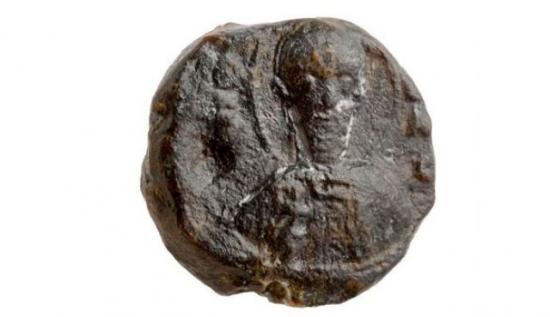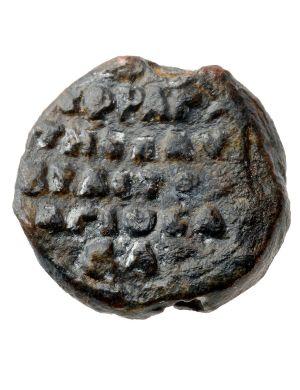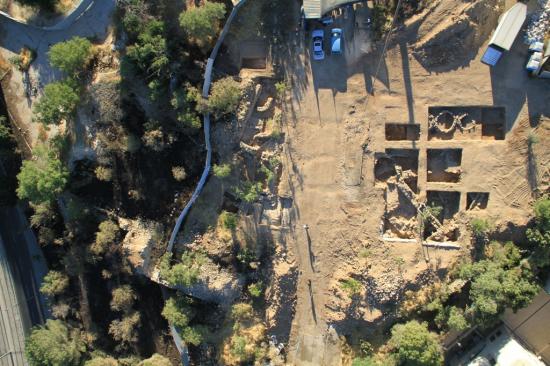Nir Hasson
Source - http://www.haaretz.com/archaeology/1.595523
The lead seal is the first found bearing the image of St. Sabas, a huge local figure 1,500 years ago, say archaeologists.

Seal of Mar Sabas, dating from about 800 years ago. Photo by Clara Amit, courtesy of the Israel Antiquities Authority
A rare seal from the Crusader era has been found in Jerusalem while excavating the Monastery of St. Sabas.
While the lead seal dates to some 800 years ago, it bears the likeness of St. Sabas, one of the most important personalities active in Jerusalem during the Byzantine period, some 1,500 years ago.
Despite the importance of St. Sabas – or according to his Syriac name, Mar Saba – to Christian history in Israel, no seals with his image had been found before.
St. Sabas was one of the most influential leaders of the Christian monastic movement that developed in the Judean Desert during the Byzantine period. He established several monasteries, but his crowning achievement was the construction of the Monastery of St. Sabas, referred to as the “Great Laura” in the Byzantine period.
Situated on a cliff overlooking Nahal Kidron, it is the only monastery in the Judean Desert continuously inhabited since its foundation. At the time the seal was in use, the monastery had hundreds of monks and this day has about 10 Greek monks in residence.
During the summer of 2012, the Israel Antiquities Authority conducted two archaeological salvage digs at Horbat Mizmil, an Arab village before 1948 and now a site slated for development in the Bayit Vegan neighborhood in Jerusalem.
It is the norm in Israel to examine land slated for development for antiquities.
The salvage digs revealed the remains of a farmstead dating from the Byzantine period.
The archaeologists discovered that the site had been abandoned at the end of the Byzantine period, only to be resettled during the Crusader period (11th-12th centuries C.E.). It continued to grow, reaching its maximum size during the Mamluk period (13th-15th centuries C.E.).
It was during excavation of the Crusader era layer that the seal with the saint's bearded face was found. Other artifacts uncovered during the digging reflected daily life in the farmstead.
The seal, or bulla in Latin, was used to seal letters with wax, so they wouldn't be opened by unauthorized persons (or if they were, it would be obvious). It consisted of two blank lead disks connected by a string passing through a channel between them.
When sealing the letter, these disks were pressed together, creating the double-faced seal.
The 800-year-old seal is in excellent condition. The saint's figure wearing a himation, and holding a cross in his right hand, is discernible on one side of the seal. The reverse bears an inscription in Greek: "This is the seal of the Laura of the Holy Sabas."
The object was examined by Dr. Robert Kool of the IAA and Prof. Jean-Claude Cheynet of France, who identified it as a seal stamped by the Laura – the Monastery of St. Sabas during the Medieval period.
Dr. Yuval Baruch – Israel Antiquities Authority's archaeologist responsible for Jerusalem and its environs – presented the unique find to the Greek Orthodox Patriarch of Jerusalem, Theophilos III.
According to Benyamin Storchan and Dr. Benyamin Dolinka – excavation directors on behalf of the Israel Antiquities Authority – the excavated farmstead could be a farming settlement sold to the monastery in 1163-1164.
A document from the archives of the Church of the Holy Sepulchre during the Crusader period mentions a farming settlement called Thora, whose whereabouts are unknown. It is quite possible the document refers to this site, they say.

The Greek inscription on the reverse side of the Mar Sabas seal.Photo by Clara Amit, courtesy of the IAA

The Byzantine-era farmstead dating from about 1,500 years ago found in Bayit Vegan, Jerusalem, where the Mar Sabas seal was found.Photo by Clara Amit (Courtesy of Israel Antiuities Authority